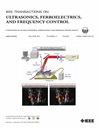Deep Learning in Ultrasound Localization Microscopy: Applications and Perspectives
IF 3.7
2区 工程技术
Q1 ACOUSTICS
IEEE transactions on ultrasonics, ferroelectrics, and frequency control
Pub Date : 2024-09-17
DOI:10.1109/TUFFC.2024.3462299
引用次数: 0
Abstract
Ultrasound localization microscopy (ULM) is a novel super-resolution imaging technique that can image the vasculature in vivo at depth with resolution far beyond the conventional limit of diffraction. By relying on the localization and tracking of clinically approved microbubbles injected in the blood stream, ULM can provide not only anatomical visualization but also hemodynamic quantification of the microvasculature. Several deep learning approaches have been proposed to address challenges in ULM including denoising, improving microbubble localization, estimating blood flow velocity, or performing aberration correction. Proposed deep learning methods often outperform their conventional counterparts by improving image quality and reducing processing time. In addition, their robustness to high concentrations of microbubbles can lead to reduced acquisition times in ULM, addressing a major hindrance to ULM clinical application. Herein, we propose a comprehensive review of the diversity of deep learning applications in ULM focusing on approaches assuming a sparse microbubble distribution. We first provide an overview of how existing studies vary in the constitution of their datasets or in the tasks targeted by the deep learning model. We also take a deeper look into the numerous approaches that have been proposed to improve the localization of microbubbles since they differ highly in their formulation of the optimization problem, their evaluation, or their network architectures. We finally discuss the current limitations and challenges of these methods, as well as the promises and potential of deep learning for ULM in the future.超声定位显微镜中的深度学习:应用与展望》。
超声定位显微镜(ULM)是一种新型超分辨率成像技术,可对体内血管进行深度成像,分辨率远远超过传统的衍射极限。通过对注入血流中的临床认可的微气泡进行定位和跟踪,ULM 不仅能提供不同组织微血管的解剖可视化,还能提供血液动力学量化。目前已提出了多种深度学习方法来应对超低功耗成像中的挑战,包括去噪、改善微气泡定位、估计血流速度或进行像差校正。所提出的深度学习方法往往能提高图像质量并缩短处理时间,因而优于传统方法。此外,这些方法对高浓度微气泡的鲁棒性可缩短超低速磁共振成像的采集时间,从而解决超低速磁共振成像临床应用的一大障碍。在此,我们对深度学习在超短波成像中的应用多样性进行了全面回顾,重点关注假设微气泡分布稀疏的方法。我们首先概述了现有研究在数据集构成或深度学习模型目标任务方面的差异。我们还将深入探讨为改善微气泡定位而提出的众多方法,因为这些方法在优化问题的表述、评估或网络架构方面存在很大差异。最后,我们将讨论这些方法目前存在的局限性和挑战,以及深度学习在未来用于 ULM 的前景和潜力。
本文章由计算机程序翻译,如有差异,请以英文原文为准。
求助全文
约1分钟内获得全文
求助全文
来源期刊
CiteScore
7.70
自引率
16.70%
发文量
583
审稿时长
4.5 months
期刊介绍:
IEEE Transactions on Ultrasonics, Ferroelectrics and Frequency Control includes the theory, technology, materials, and applications relating to: (1) the generation, transmission, and detection of ultrasonic waves and related phenomena; (2) medical ultrasound, including hyperthermia, bioeffects, tissue characterization and imaging; (3) ferroelectric, piezoelectric, and piezomagnetic materials, including crystals, polycrystalline solids, films, polymers, and composites; (4) frequency control, timing and time distribution, including crystal oscillators and other means of classical frequency control, and atomic, molecular and laser frequency control standards. Areas of interest range from fundamental studies to the design and/or applications of devices and systems.

 求助内容:
求助内容: 应助结果提醒方式:
应助结果提醒方式:


